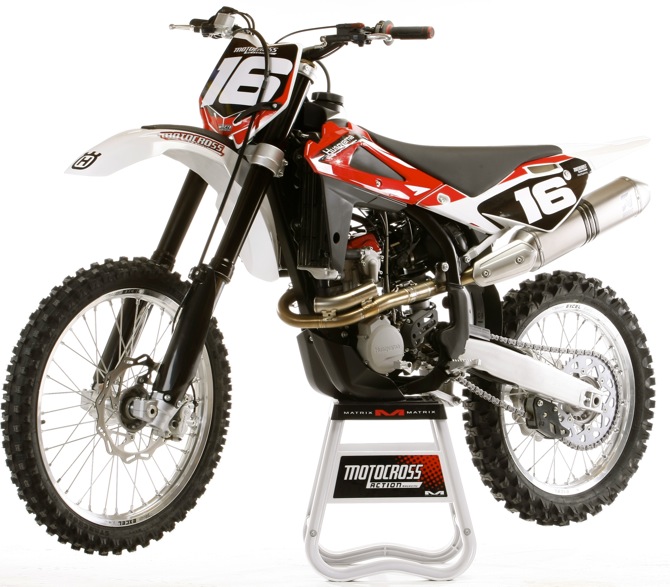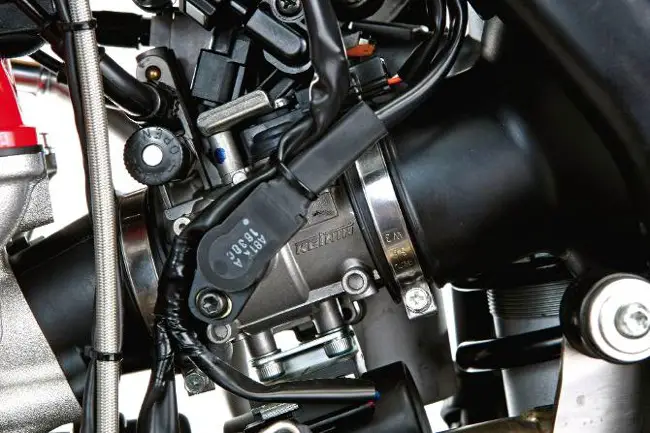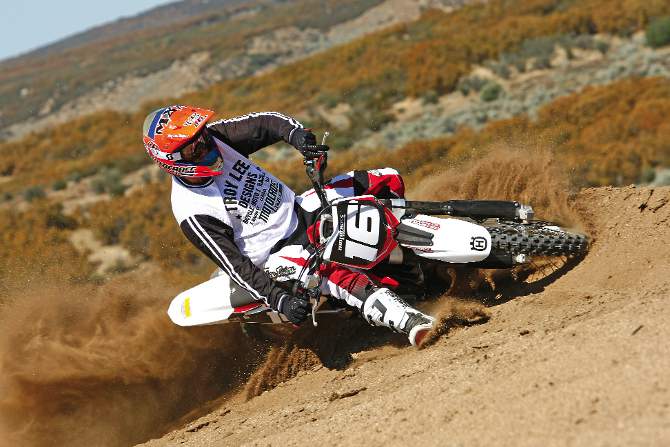MXA’S 2012 HUSQVARNA TC250 MOTOCROSS TEST: SOMETHING GOOD CAME FROM BMW QUITTING FORMULA 1
Q: WHAT’S THE STORY WITH THE TC250?
A: After flying under the U.S. radar for a few years, Husqvarna debuted the current-generation TC250 as a 2010 model. The big buzz was about its all-new “X Lite” engine, which was touted as the smallest, lightest 250cc four-stroke engine in the class. At 48 pounds, it was a whopping 10 pounds lighter than its competitors’ mills. The new-generation 2010 bike wasn’t all about the engine, as Husky went over the entire thing. Highlights included a specifically designed frame?instead of sharing with the 450?and Kayaba forks replacing the Marzocchis. In a test nutshell, the chassis was good, but it was difficult to start and needed more horsepower.
For 2011, the TC250 got a Mikuni 45mm EFI throttle body to replace the carb. It cured the starting ailment, but sadly made the powerband feel even softer, which was quite common for 250s going to EFI. Also soft were the suspension settings, making for a package that was fun to ride but not ready to race. For 2012, Husqvarna set out to change that.
Q: WHAT WAS HUSQVARNA’S HORSEPOWER GAME PLAN FOR 2012?

2012 Husky TC250: Most OEMs only make small updates in the first three years of a totally redesigned bike. But, Husqvarna isn’t like most OEMs. For 2012, they went whole hog with significant engine, chassis and suspension changes.
A: Husqvarna has been marketing “Formula 1-inspired” engine improvements since the X Lite debuted, and for good reason. The man in charge of engine development at Husqvarna is Ralf Kleid, who had been on BMW’s F1 effort since 2000. And when BMW decided to pull out of F1 in 2009, Ralf transferred to BMW’s new venture at Husqvarna. Husqvarna decided to put Ralf in charge of the 250 engine development.
Ralf and the folks at Husqvarna had no delusions about the TC250 powerplant; they knew what they needed to work on for 2012. They have continued to move toward Formula 1-style engine features and make major design improvements instead of smaller and less expensive massaging improvements. By getting the big aspects right, Husqvarna hopes to ensure more power gains in the future. In short, that means that the Husky engineers didn’t try to coax every possible bit of power out of the current configuration. Instead they were looking at making generational improvements that will pay dividends in the long run.
Q: WHAT WERE THE 2012 ENGINE DESIGN CHANGES?
A: There are seven new engine components for the 2012 TC250:
(1) Kicked bucket. The tappet-actuated valves of the previous TC250 were replaced by DLC (diamond-like coated) finger-followers to achieve two goals: First, the 8mm-wide finger-followers created more space and allowed for larger-diameter valves than the 20mm-diameter tappets could fit. Second, the finger-followers let the valves open deeper into the cylinder head. On an interesting side note, the springs are from Peterson, and the titanium valves are from Del West. The rest is from Italy.
(2) Cylinder head. A new cylinder head design allows for larger-diameter valves and compatibility with the new drivetrain system.
(3) Piston. The piston’s dome is corrected to the new valve angles of the head. As an added benefit, it weighs less. The piston keeps its 79mm bore, which is 2mm larger than any of the “Big Five.” Husqvarna feels that this strategy will help them in the continuing quest for more peak power on top and that they can make up the trade in bottom-end in other areas.
(4) Air horn. There is a new airbox and velocity stack for more airflow and power at high rpm. Husqvarna made the intake straighter and massaged the trumpet shape to eke out some more performance.
Motorhead: The 48-pound X Lite TC250 engine gets finger followers, larger diameter valves, a new piston and head. Husqvarna is on a mission to get more power.
(5) Engine management. Husqvarna traded last year’s odd-duck Mikuni EFI system for the ubiquitous Keihin EFI package?citing adjustability as a major reason for the change. Apparently with the Mikuni system, there weren’t enough adjustment points in the mapping. Between each adjustment point, EFI fuel delivery has a linear interpolation, but the engine demands are nonlinear. Husqvarna engineers had to compromise on settings. The Keihin system offered the engineers more adjustment with fuel and ignition mapping.
(6) Stick coil. The external coil ignition has been upgraded to a stick coil. The stick coil was chosen because it is lighter, more compact and cheaper. It was not an item that would or could improve performance.
(7) Exhaust. Akrapovic designed a new exhaust system with a resonance chamber on the head pipe for the 2012 TC250.

Q: WHAT ELSE IS NEW FOR 2012?
A: The chassis and suspension updates are as follows:
(1) Frame. Formerly white, the chromoly frame is now black and has been reinforced with strengthening gussets near the head for increased rigidity. These strengthening plates add about 5 pounds to the 2012 model compared to the 2011 TC250.
(2) Shock. The previously spec’ed Sachs shock has been replaced with a Kayaba shock. There were two reasons for this: First, Husky wanted to have the same brand of components?front and rear?to eliminate any corporate finger pointing between Sachs and Kayaba. Second, Kayaba shocks are a known quantity that can be serviced anywhere in the USA?not so with the Sachs shock.
(3) Forks. The settings have been revised and stiffened significantly. To our untrained eyes, these appear to be Yamaha-spec forks from a few years ago.
Throttle body test: Husqvarna dropped last year’s Mikuni EFI system for the Keihin because Keihin’s fuel management system allows for more adjustment points between any given throttle opening/rpm setting.
(4) Plastics. Polisport supplied in-mold plastics with new black-and-red graphics. In-mold graphics are more durable than stickers.
(5) Rims. Silver anodized Excel rims replace the previous black ones.
Q: HOW FAST IS THE BIKE?
A: The good news?significantly faster than last year. For all their engine work, Husqvarna was rewarded with a marked improvement in overall power and responsiveness. Oddly, testers got their first big clue to power improvement by noting an improvement in the bike’s handling. When laid over into a rut or berm, a rider will often use power to help stand the bike back up on the exit of the corner. When hammering the throttle on last year’s TC250 in this situation, nothing would happened. The rider would be forced to knife the front tire into the dirt to right the machine. Thankfully, the 2012 has some pep. The bike isn’t blessed with a whole lot of bottom-end, but the responsiveness and increase in overall power made it much easier to balance and to get out of trouble in a potential low-side crash situation.
At a cruise, the TC250 is very broad and easy to ride, but for any kind of speed, it needs to be revved. Once into the top-end, the TC250 could start covering some ground quickly. The only fly in the ointment was getting up there. The power was slow to build. An extra tooth on the rear and/or an aftermarket exhaust are two ways to help get to the TC250’s sweet spot. The peak horsepower of the TC250 wasn’t world-beating, but last year it was tail-end Charlie by a large margin. This year it’s competitive?although not with the hyper power of the 2012 Kawasaki KX250F.
Q: HOW WAS THE GEARING?
A: The slow-revving powerband exacerbated the tall gearing. Last year we went up two teeth, from 13/50 to 13/52. With the extra boost from the reworked engine, a 13/51 is the best choice for most riders and tracks with the 2012.
Q: HOW MUCH DOES IT WEIGH?
A: We thought it would be light (thanks to the featherweight X Lite engine). In human terms, most people carry excess weight in their midsections, but the TC250 is just the opposite. The engine in the middle of the TC250 is very light, but the rest of the bike is heavy. At 229 pounds on the trusty MXA scale, the TC250 is 2 pounds lighter than the electric-starter-equipped 2012 KTM 250SXF, but 5 pounds heavier than the KX250F and RM-Z250. It is an astounding 11 pounds shy of the class leader, the still-carbureted Yamaha YZ250F.
Sacked Sachs: The TC250 now comes with a Kayaba shock, facilitating any revalving by U.S. suspension companies.
Q: HOW DOES IT HANDLE?
A: The overall geometry of the TC250 is close to neutral. Husqvarna is on the right track with the frame. In rough places, where a razor-handling Honda or Suzuki 250 are prone to getting head-shake, the Husky remains stable. Coming into turns and ruts where the KX250F has a bit of a tendency to understeer, the TC250 does what it’s told. It’s not exciting or exceptional, but it does everything well.
Other aspects that noticeably factored into the TC250’s handling included weight, tires and suspension. Wrestling with the bike during a long moto, riders could feel the extra weight when rolling into turns. Plus, the Michelin Starcross MS3 front tire wouldn’t be our first choice on hard dirt. It liked to push sometimes. On a final note, the TC250 needs softer forks. Bikes initiate turns better when the front end is sucked down under braking because it steepens the head angle. Overly stiff forks don’t dive and tend to understeer.
Q: HOW WERE THE FORKS?
A: Husqvarna overcompensated with their updated 2012 fork settings. Last year the forks had 0.43 kg/mm springs, and MXA bumped them up to 0.45. This year the factory installed 0.47s and 20cc more oil. Last year we complained of the jarring feeling of the forks bottoming out over every big bump; this year we complained of the jarring feeling of the forks not moving through their stroke. But while the symptoms are similar, the cure for stiffness was much easier and more affordable than the cure for softness. We removed 20cc of fork oil and backed out the compression clicker to put the forks within the zone of a typical 250F pilot.
Q: WHAT ARE MXA’S RECOMMENDED FORK SETTINGS?
A: Here is what we ran in our 2012 Husqvarna TC250 (the stock settings are in parentheses):
Spring rate: 0.47 kg/mm
Compression: 16 clicks out (12 clicks out)
Rebound: 12 clicks out (10 clicks out)
Oil height: 290cc (310cc)
Fork leg height: 5mm up
Note: A bigger, faster rider will still benefit from removing the fork oil, but should start with the stock clicker settings. A minicycle transplant may need softer springs.
Easy squeeze: The TC250’s Braking and Brembo combo is a proven winner. We could go in hot and stop in a hurry.
Q: HOW WAS THE NEW KAYABA SHOCK?
A: It was educational. We discovered, true to Husqvarna’s word, the overall performance of the Kayaba shock wasn’t really superior to last year’s Sachs shock on baseline performance. Since 2010, faster test riders have noted a slight looseness in how the rear of the TC250 tracks over bumps, and they attributed it to the shock. With the Kayaba-equipped 2012, we experienced the same sensation. Speeding up the rebound (out on the clicker) to try to get the rear end to follow the bumps led to more hopping. Going in the opposite direction to deaden the feeling of the shock, which masked the feeling, didn’t seem to address it. High-speed compression adjustments didn’t seem to bring relief, either. The looseness must be chassis-related.
Q: WHAT ARE MXA’S RECOMMENDED SHOCK SETTINGS?
A: Here is what we ran in our 2012 Husqvarna TC250 (the stock settings are in parentheses):
Spring rate: 5.3 kg/mm
Hi-compression: 1-1/2 turns out (1-1/4 turns out)
Lo-compression: 14 clicks out
Rebound: 6 click out (10 clicks out)
Race sag : 100mm

Q: WHAT DID WE HATE?
A: The hate list:
(1) Grips. We weren’t crazy about the stock Dominos in the first place, but when the left grip started to twist around the bar, it was downright irritating.
(2) Number plates. Even if all European races use transponders to score, we still want spectators to be able to recognize our bikes and see the numbers.
(3) Upper reach. We love a screamer (top-end) powerband, but it could be more accessible. Gearing is a cheap fix, and it feels like the pipe is slowing down the revs.
(4) Catch. Sharp Italian styling is cool, but we caught our pants on a couple of spots on the shrouds.
Q: WHAT DID WE LIKE?
Pep rally: With improved throttle response, TC250 pilots had the hit necessary to rail ruts and blast berms with confidence.
A: The like list:
(1) Price. Although once-prominent, Husqvarnas count as exotic European bikes today. This label, along with the R&D time and upgraded components, carries the assumption that the TC250 will be expensive, but it’s not true. The $6999 price is $250 less than the Yamaha, which is the cheapest of the Big Five brands.
(2) Shock. The Kayaba shock wasn’t necessarily better than the Sachs unit, but we could name 20 shops in SoCal who can make the Kayaba perform better.
(3) Frame. We like steel frames. They have a more resilient feel on the track and offer more access to the carb and components off the track. The Husqvarna frame is a little too porky, though.
(4) Wheels. Silver rims stay nice longer than black rims. The Grimeca hubs are very attractive.
(5) Front brakes. A Brembo dual-piston caliper and a 260mm Braking rotor get the job done and then some.

Q: WHAT DO WE REALLY THINK?
A: For 2012, Husqvarna targeted the exact areas they needed to. They didn’t pussyfoot around with a simple cam, piston or porting change to nudge out a little more power; they went with a major redesign. Make no mistake, Husqvarna is close to knocking at the door of their competitors, and they are doing so with a unique bike that costs less.










Comments are closed.